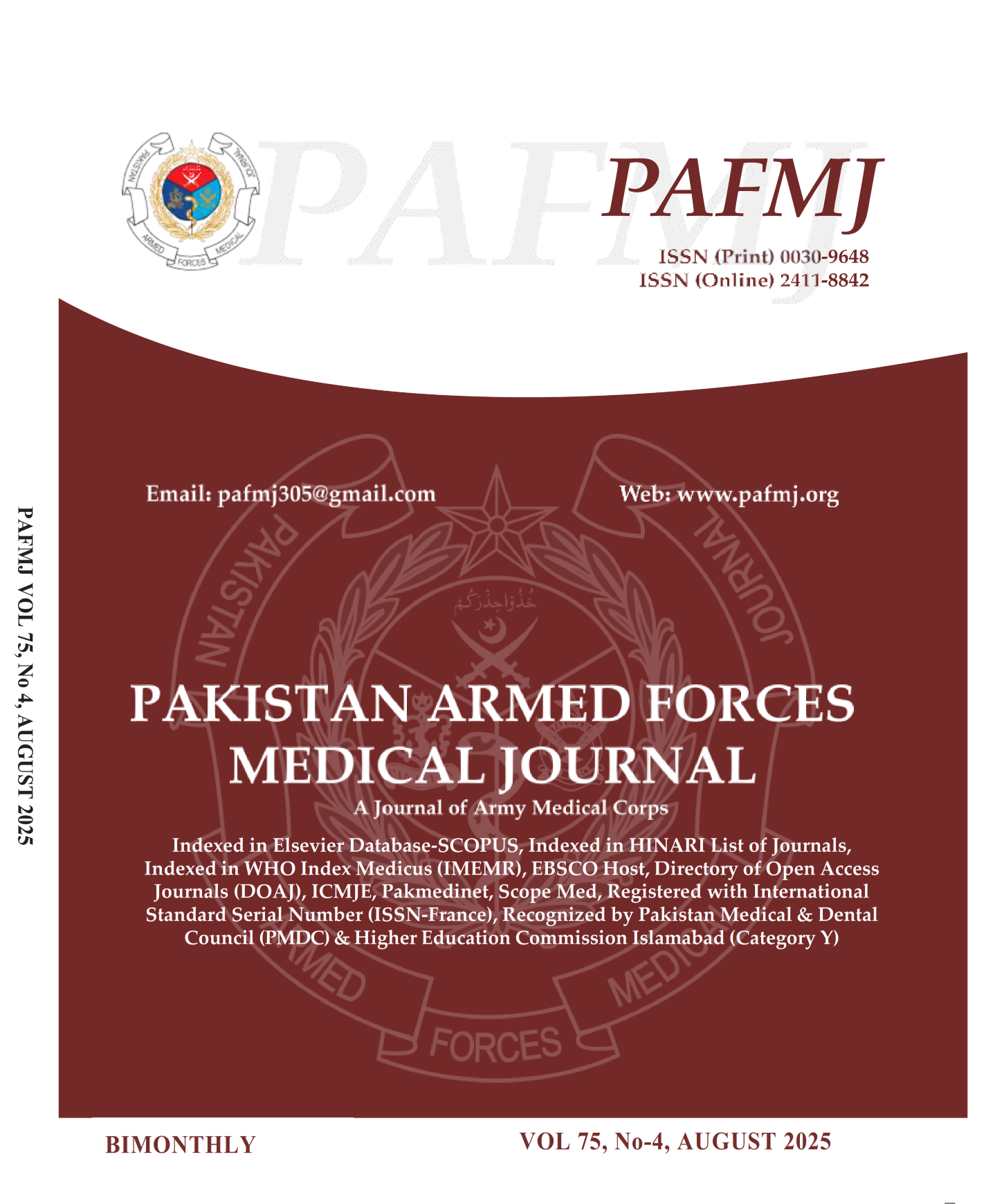Hemostasis: A Comparative Analysis of Hot Saline and Room Temperature Saline in Sinus Surgery
DOI:
https://doi.org/10.51253/pafmj.v75i4.12067Keywords:
Functional endoscopic sinus surgery (FESS), hemostasis, hot Saline irrigation (HSI), and intraoperative blood lossAbstract
Objective: To evaluate the efficacy of room temperature Saline irrigation (RTSI) and hot Saline irrigation (HSI) in controlling intraoperative bleeding during functional endoscopic sinus surgery (FESS).
Study Design: Quasi-experimental study
Place and Duration of Study: Department of Otorhinolaryngology, Combined Military Hospital, Rawalpindi, Pakistan from Jul 2000 to Dec 2022.
Methodology: Sixty-two patients with chronic rhinosinusitis undergoing functional endoscopic sinus surgery were randomly assigned to two treatment Groups. One Group received 20 mL of 50°C Saline irrigation, and the other received 20 mL of 18°C Saline irrigation, administered every 10 minutes during the procedure. The study assessed the intraoperative bleeding score, average arterial pressure, and duration of the surgical procedure.
Results: The Boezaart endoscopic field of view score was significantly better in the Group that received 49°C Saline Group (Median (IQR)= 3.00 (3.00-2.00)) compared to the Group that received 18°C Saline Group (Median(IQR)= 2.00(2.00-1.00)), with a statistically significant p-value of 0.003. Additionally, the operating time was notably shorter in the 49°C Saline Group (114.29 ± 14.86 minutes) as compared to the 18°C Saline Group (124.48 ± 15.13 minutes), with a p-value of 0.010. Total blood loss was significantly lower in the 49°C Saline Group (Median (IQR)= 258.00 (278.00 – 224.00)) compared to the 18°C Saline Group (Median(IQR)= 221 (254.00 – 200.00)), with a p-value of 0.008.
Conclusion: Intranasal hot Saline irrigation during functional endoscopic sinus surgery reduces blood loss, shortens operative time, and enhances the quality of the surgical field without affecting intraoperative hemodynamic stability.
Downloads
References
1. Alsaleh S, Manji J, Javer A. Optimization of the surgical field in endoscopic sinus surgery: an evidence-based approach. Curr Allergy Asthma Rep 2019; 19: 1-10.
https://doi.org/10.1007/s11882-019-0847-5
2. Poetker DM, Smith TL. Adult chronic rhinosinusitis: surgical outcomes and the role of endoscopic sinus surgery. Curr Opin Otolaryngol Head Neck Surg 2007; 15(1): 6-9.
https://doi.org/10.1097/MOO.0b013e328011bc8c
3. Zhang B, Zhuang L, Cai C, Qi Y. Effect of Nasal Submucosal Injection of Low-concentration Epinephrine on Visual Field Visualization in Endoscopic Sinus Surgery: A Systematic Review and Meta-analysis. Ear Nose Throat J 2023:01455613231192824.
https://doi.org/10.1177/01455613231192824
4. Abdullah B, Singh S. Surgical interventions for inferior turbinate hypertrophy: a comprehensive review of current techniques and technologies. Int J Environ Res Public Health 2021; 18(7): 3441.
https://doi.org/10.3390/ijerph18073441
5. Barak M, Yoav L, Abu el-Naaj I. Hypotensive anesthesia versus normotensive anesthesia during major maxillofacial surgery: a review of the literature. Sci World J 2015: 2015: 480728.
https://doi.org/10.1155/2015/480728
6. Koskinas I, Terzis T, Georgalas C, Chatzikas G, Moireas G, Chrysovergis A, et al. Posterior epistaxis management: review of the literature and proposed guidelines of the hellenic rhinological-facial plastic surgery society. Eur Arch Oto-Rhino-Laryngol 2023: 1-15.
https://doi.org/10.1007/s00405-023-08310-4
7. Ranford D, Fu B, Surda P, Rudd J. Hot saline irrigation for haemostasis in functional endoscopic sinus surgery: a systematic review and meta-analysis. J Laryngol Otol 2022; 136(8): 676-682.
https://doi.org/10.1017/S0022215121003698
8. Özmen S, Özmen ÖA. Hot saline irrigation for control of intraoperative bleeding in adenoidectomy: a randomized controlled trial. Otolaryngol Head Neck Surg 2010; 142(6): 893-897.
https://doi.org/10.1016/j.otohns.2010.03.010
9. Grose E, Li AY, Lee JM. Clinical outcomes of dupilumab therapy in chronic rhinosinusitis with nasal polyps in a Canadian tertiary care rhinology practice. Allergy Asthma Clin Immunol 2023; 19(1): 1-6.
https://doi.org/10.1186/s13223-023-00782-7
10. Athanasiadis T, Beule AG, Wormald PJ. Effects of topical antifibrinolytics in endoscopic sinus surgery: a pilot randomized controlled trial. Am J Rhinol 2007; 21(6): 737-742.
https://doi.org/10.2500/ajr.2007.21.3097
11. Gan EC, Alsaleh S, Manji J, Habib AR, Amanian A, Javer AR. Hemostatic effect of hot saline irrigation during functional endoscopic sinus surgery: a randomized controlled trial. Int Forum Allergy Rhinol 2014; 4(11): 877-884. https://doi.org/10.1002/alr.21376
12. Alsaadi N, Hassoune A, Haldeman S, Williamson KM, Plautz W, Hoteit L, et al. Effect of Irrigation Fluid Composition on Hemostasis in Mouse Bleeding Models. Shock 2022; 58(6): 549-555
https://doi.org/10.1097/SHK.0000000000002009.
13. Shahsavarinia K, Faridaalaee G, Ahranjani RE, Balafar M, Milanchian N, Hajebrahimi S, et al. What is the Best Management for Geriatric Epistaxis? A Comprehensive Systematic Review and Meta-analysis. Int J Drug Res Clin 2023(1)2: e11.
https://doi.org/10.34172/ijdrc.2023.e11
14. Osman MEA, Fahmi R, Aboulwafa A. Evaluation of nasal hot water irrigation in the management of posterior epistaxis. Egypt J Neck Surgery Otorhinolaryngol 2022; 8(3): 8-17.
https://doi.org/10.21608/EJNSO.2022.254284
15. Nagarajah D, Kueh YC, Lazim NM, Abdullah B. The hemostatic effect of hot saline irrigation in endoscopic sinus surgery: a systematic review and meta-analysis. Syst Rev 2022; 11(1): 246.
https://doi.org/10.1186/s13643-022-02113-0
16. Hathorn IF, Habib A-RR, Manji J, Javer AR. Comparing the reverse Trendelenburg and horizontal position for endoscopic sinus surgery: a randomized controlled trial. Otolaryngol Head Neck Surgery 2013; 148(2): 308-313. https://doi.org/10.1177/0194599812466529
17. Ko MT, Chuang KC, Su CY. Multiple analyses of factors related to intraoperative blood loss and the role of reverse Trendelenburg position in endoscopic sinus surgery. Laryngoscope 2008; 118(9): 1687-1691.
https://doi.org/10.1097/MLG.0b013e31817c6b7c
18. Wormald PJ, Van Renen G, Perks J, Jones JA, Langton-Hewer CD. The effect of the total intravenous anesthesia compared with inhalational anesthesia on the surgical field during endoscopic sinus surgery. Am J Rhinol 2005; 19(5): 514-520.
Downloads
Published
Issue
Section
License
Copyright (c) 2025 Marina Khan, Maqbool Raza, Jahangir Ahmed Afridi, Sheikh Sadaat Ullah Waleem, Nauman Jamil, Waqas Hashmi

This work is licensed under a Creative Commons Attribution-NonCommercial 4.0 International License.















